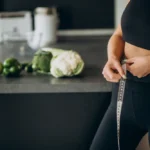“Can you really lose weight eating more protein?” That’s the question I asked myself when I found my jeans getting tighter and my energy dipping after long workdays. Like many, I was tempted by extreme diets, cutting out carbs, sugars, even full meals. But the one strategy that truly made a difference? Upping my protein intake — smartly and consistently. And I’m here to share how I approached it, what worked, and how you can make it work for you too.
Why Protein is a Game-Changer for Weight Loss
It’s not just fitness influencers who rave about protein. Science backs it too. Studies published in the American Journal of Clinical Nutrition show that higher-protein diets can improve appetite control, increase satiety, and even boost metabolic rate during weight loss phases.
Dr. Sara Thomas, a clinical nutritionist from the UK, notes: “Protein isn’t just about muscle building. It supports hormone regulation, immune function, and helps maintain lean body mass — crucial during any fat-loss phase.”
For me personally, switching to a protein-focused approach meant I wasn’t starving by 4 p.m., I had fewer cravings at night, and I actually looked forward to my meals. It wasn’t about eating steak five times a day — it was about smart balance.
Before You Begin: Important Considerations
- Consult a GP or dietitian before starting any restrictive plan, especially if you have health conditions.
- This plan suits people aiming to lose fat while preserving muscle.
- Stay hydrated and aim for light to moderate daily activity to complement the meal plan.
7-Day High-Protein Diet Plan for Weight Loss
Each day follows a pattern of 30–40% protein, 30% complex carbs, and 30–40% healthy fats. Here’s what a week could look like:
Day 1 – Reset and Refuel
- Breakfast: Scrambled eggs (2 whole, 2 whites) + half avocado + 1 slice sourdough
- Snack: Greek yoghurt (unsweetened) + a few almonds
- Lunch: Grilled chicken salad with olive oil vinaigrette, cherry tomatoes, and mixed greens
- Snack: Boiled egg + cucumber sticks
- Dinner: Baked salmon + steamed broccoli + quinoa
Note: I tried swapping salmon with tuna one evening and noticed I felt bloated. Everyone’s digestion differs, so find your favourites.
Day 2 – Energy Without Sugar Highs
- Breakfast: Protein smoothie with unsweetened almond milk, 1 scoop whey protein, half banana, and chia seeds
- Snack: Hard-boiled egg + 1 rice cake
- Lunch: Turkey breast wrap with whole-grain tortilla + spinach and hummus
- Snack: Edamame beans (lightly salted)
- Dinner: Stir-fried tofu + bell peppers + cauliflower rice
Day 3 – Midweek Focus
- Breakfast: Cottage cheese + mixed berries + flaxseeds
- Snack: Handful of pumpkin seeds
- Lunch: Grilled lean beef + sweet potato mash + steamed kale
- Snack: Protein bar (low sugar)
- Dinner: Chicken tikka skewers + mixed vegetables
Personal Tip: I initially thought cottage cheese was bland, but adding cinnamon and berries made it surprisingly satisfying.
Day 4 – Lighter But Still Filling
- Breakfast: Two poached eggs on rye toast + tomato slices
- Snack: Celery sticks + almond butter
- Lunch: Lentil and vegetable soup + boiled egg
- Snack: Greek yoghurt + flaxseeds
- Dinner: Grilled prawns + brown rice + roasted asparagus
Day 5 – End of the Workweek Boost
- Breakfast: Protein pancakes (oats, egg whites, banana, protein powder)
- Snack: Turkey jerky
- Lunch: Tuna salad with chickpeas, lemon dressing
- Snack: Carrot sticks + hummus
- Dinner: Chicken breast + roasted courgette + bulgur wheat
Day 6 – Weekend Reboot
- Breakfast: Omelette with spinach, mushroom, and feta
- Snack: Mixed nuts (small handful)
- Lunch: Grilled halloumi + couscous salad + roasted peppers
- Snack: Protein shake + berries
- Dinner: Turkey meatballs + zoodles (courgette noodles) + marinara sauce
Day 7 – Reflect and Reset
- Breakfast: Greek yoghurt parfait with granola and strawberries
- Snack: Boiled eggs
- Lunch: Baked cod + steamed carrots + wild rice
- Snack: Roasted chickpeas
- Dinner: Chicken stir-fry with veggies + brown rice
Expert Tips to Maximise Results
- Dr. James Carter, sports dietitian: “Spacing your protein intake evenly throughout the day helps prevent muscle loss and improves satiety.”
- Meal Prep: Batch-cook proteins (chicken, tofu, eggs) to save time and avoid mid-week takeout temptations.
- Track Progress: Don’t just rely on the scale. Measure energy levels, sleep quality, and how clothes fit.
Common Questions (FAQs)
Is a high-protein diet safe for everyone?
Generally, yes — but those with kidney issues should consult a healthcare provider first. A moderate increase in protein is safe for most healthy adults.
Can vegetarians follow this plan?
Absolutely. Swap meats for legumes, tofu, tempeh, and protein-rich grains like quinoa and buckwheat.
What’s the ideal protein intake per day?
According to the British Nutrition Foundation, 0.75g per kg of body weight is the minimum — but for fat loss and muscle retention, 1.2–1.6g/kg is more effective.
How soon can I see results?
Many notice reduced cravings and more stable energy within 3–5 days. Visible weight changes may take 2–4 weeks depending on consistency and overall lifestyle.
Final Thoughts
This isn’t a magic solution — but it is a sustainable one. A 7-day protein-focused plan helped me kickstart better eating habits, feel more in control of my appetite, and start shedding fat without sacrificing flavour or fullness.
Give it a go, tweak what suits your body, and stay consistent. If you’ve tried this or have your own protein-rich tips to share, I’d genuinely love to hear them. Drop a comment or message — let’s swap notes.
Sources:
- British Nutrition Foundation
- American Journal of Clinical Nutrition
- NHS UK Dietary Guidelines




